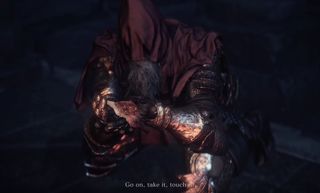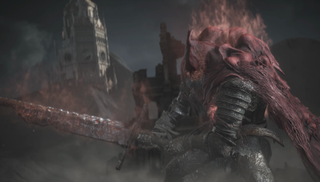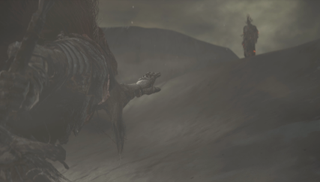Why Dark Souls 3: The Ringed City’s final boss is one of the series’ best
A pitiful, admirable figure teaches as much as he terrorizes.

Who knew the final boss of the entire Dark Souls series would be a super sad uncle? Slave Knight Gael represents the downtrodden, a person who, through endless trials and agony beneath the corrupt rule of the Lothric royalty holds onto the hope of a new beginning. Off to find the Dark Soul pigment in the ringed city, his journey precedes your own, marked by the occasional Gael phantom encouraging you to “take the plunge” into a soft pile of ash below. The pigment is all his niece needs to paint a new world for man, free from the cycle of fire. It sounds too good to be true and it’s Gael’s adherence to the belief it is true that makes him such an admirable dude.
Shame we have to kill him, really. He’s the Old Yeller of Dark Souls, a sympathetic character gone mad, but instead of a shed we take him out to the precipice of an era for one of the best boss fights in the series and an appropriate close to an otherwise inconsistent final act.
After a massive jump forward in time, we find Gael as a violent, disillusioned version of his former self, killing every living thing that might get him closer to finding the pigment. He mirrors the player’s journey through space and time and toil to find the titular series MacGuffin, but more so he represents the best of Dark Souls boss design, a pure distillation of everything great about the combat.
Fun-damentals
The bigger a Dark Souls boss, the more frustrating they are to fight, generally. Big usually implies a beastly form with knotty limbs and billowing wings. Size is always impressive, but strange anatomies make big bosses harder to track, especially once they start moving and swinging and shooting lasers out of some hidden hole. When locking on, the camera either centers on their mass and pulls you under their legs, where other limbs crowd the foreground and make precision attacks and evades nearly impossible. The process of learning the behavior and capabilities of a given monster piles on the trial and error necessary to understand them. Studying monstrous bosses can be fun and might eventually give way to a well-designed fight beneath a pile of your dead bodies (Ludwig from Bloodborne comes to mind), it’s just the initial buffer stage of parsing what’s in front of you that can feel unfair. Imagine starting up a round of Street Fighter 2, only to come up against a purple abyssal dragon.
Dark Souls’ combat system is at its least frustrating when fighting human figures. You can stay locked on, you know they’re wielding weapons and magic or a combination of both, and you know—roughly—what the attacks might look like. In that way, Gael’s silhouette is immediately familiar. The very first enemy you face in the first Dark Souls is a shambling undead human figure and your character’s only weapon is a broken short sword bearing a striking resemblance to Gael’s own chipped and rusted blade.

There’s no hesitation to fight the guy: it’s just you two on the edge of existence, swinging swords. An intuitive final fight means there’s less time taking mental notes on bizarre attack patterns, and more time feeling the thrill of the fight and speculating about how Gael ended up so powerful and pitiful at once. Character and mechanics collide to make that sad, exciting Dark Souls stew so many love.
It’s still hard, of course, but like a Guitar Hero song on expert, you get to play a series of increasingly complex chords progressions before the blazing solo.
The biggest gaming news, reviews and hardware deals
Keep up to date with the most important stories and the best deals, as picked by the PC Gamer team.
Stabbing lessons
To anyone watching, you’ll look like Mozart, if Mozart was known for how good he could somersault and stab sad uncles.
Gael’s most challenging traits come from a slow, clear progression of attacks added to the fight at distinct intervals. There’s no surprise second health bar accompanied by a completely different phase and moveset, and no additional foes show up to sneak in off camera or force you to repeatedly find your lock-on. The lock-on actually composes some beautiful shots, following Gael as he dashes around you or rolls and slams from above.
The angles frame him and the player against the ashen plain in a way that looks like an showdown from an old western, giving you ample time to admire the art direction while fighting for your life. Gael is all you need to focus on, with his supplemental attacks easy to keep track of in your periphery.
When Gael’s health is two-thirds full or so, a cutscene plays out, giving the player a chance to breathe and take in the mad uncle’s new upright posture. Gael’s moveset is largely the same, augmented with a scarlet flame effect from his cloak on his bigger swings, a repeating crossbow, and the Way of the White Corona spell attack.
Way of the White Corona is the first method for teaching positioning in relation to Gael his AoE spell effects, while reinforcing precise dodge-rolling skills. When he uses it, Gael fires off a cluster of white boomerang projectiles. With good timing, your dodge-roll’s invincibility frames allow you to roll toward him without taking damage, and because the projectiles eventually return to their point of origin, you’re taught to stay aware of where they were fired off in the first place. Otherwise they’ll catch you in the back, sometimes chaining into one of Gael’s deadlier combos.
In Gael’s third phase, he gets some AoE lightning spells and explosive spectral skull attacks that make use of the lessons taught by those magic boomerangs. By paying attention to the edge of your vision, the black spots where lighting is set to strike stand out against the ashen landscape, and you’re not penalized instantly for stepping on them. They detonate in order of appearance, and if you’re locked onto Gael, chances are you’ll be maneuvering around him, which is a good chance to take in your surroundings for a quick mental mapping.
As extensions of existing skill checks, the additions don’t fundamentally change how you fight, they just turn up the intensity. Swings have more reach with the scarlet cape flame, so your dodges need to be slightly more precise and the flame’s far reach punishes players that hang back for too long. They come faster too, which further tests timing and stamina management. Crossbow attacks are thrown into the mix for casters and archers, telegraphed well ahead of time by Gael’s stance (and the big fucking crossbow he whips out). They’re best dodged by sprinting, a skill that hasn’t been necessary throughout the battle so far. The new attacks don’t require changing strategies entirely, just stretching existing ones to their limit.
As relentless as his attacks become, Gael’s health isn’t infinitely large and doesn’t regenerate. Rather, his attacks become more consequential, diverse, and swift. The difficulty in fighting him isn’t gotcha trickery, it’s punishment for failing to keep up with his gently ballooning moveset. And if you keep up with the gradual schooling without getting schooled, the result is a rhythmic fight that requires use of every skill at your disposal. It’s truly difficult, but when everything comes together, fighting Gael feel effortless.
Even better than victory, the truest gratification is in reflection, seeing gulf between where your capabilities start and end up. To anyone watching, you’ll look like Mozart, if Mozart was known for how good he could somersault and stab sad uncles.
But the adrenaline and self-gratification quickly evaporate. After finishing Gael off there’s no closing cutscene, no credits sequence—only the notice that the final heir of fire has been destroyed and the last bonfire appears, a soft glow in a desert of ash. Whether you return to his niece and deliver her the Dark Soul pigment is up to you, and even then, all that’s left is a soft prayer for a new world. All that’s left is to close the game and leave the series behind. Dark Souls’ last boss never gets the final hit he worked so hard for, and it still hurts.

James is stuck in an endless loop, playing the Dark Souls games on repeat until Elden Ring and Silksong set him free. He's a truffle pig for indie horror and weird FPS games too, seeking out games that actively hurt to play. Otherwise he's wandering Austin, identifying mushrooms and doodling grackles.

Elden Ring streamer completes a level 1 playthrough beating the game's 165 bosses—on NG+7, a difficulty she had to finish the game 7 times over just to reach

FromSoftware drops another story trailer for Elden Ring's Shadow of the Erdtree DLC—giving us a glimpse at the fiery rampage that made Malenia's golden boy flee the Lands Between
Most Popular


